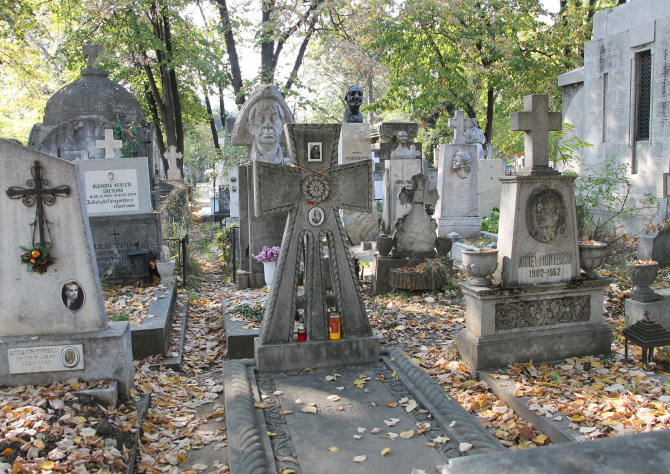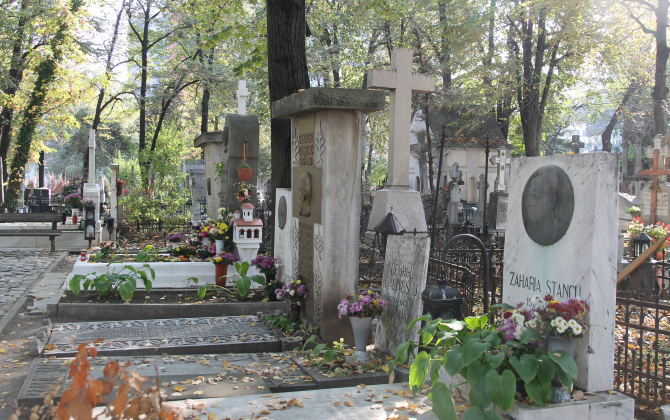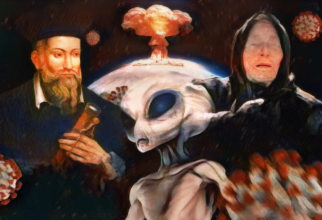One of the most interesting alleys is that of the writers. Here we find the tombs of Mihai Eminescu, I.L. Caragiale, Mihail Sadoveanu, Nichita Stănescu, Nicolae Labiș, George Coșbuc, Adrian Păunescu, Eugen Barbu, Marin Preda, Zaharia Stancu, Mihai Ralea, Mircea Nedelciu and other echoes of the written word.

Eminescu’s Tomb, always decorated with flowers Photo: Crișan Andreescu
Bellu Cemetery - on the grounds of a former garden where folk musicians used to play
In 1938, Grigore Ionescu recorded the history of the Bellu cemetery in Bucharest - Historical and Artistic Guide. It was founded in November 1859 and it was the oldest, largest and most important of the 18 cemeteries that existed in Bucharest. Until 1879, the people of Bucharest used to bury their dead in the church yards.

The tombstone of Baron Barbu Bellu’s family, who donated 28 hectares in 1873, for these to become places of eternity. “Baron Bellio Family” is the inscription on the funeral stone Photo: Crișan Andreescu
After a decision of the municipality formally forbade this, the City Council founded the cemetery, at the initiative of C.A. Rosetti. Unfortunately, by a sad coincidence, the first buried here was his son himself. We learn from the same documentary source that a famous garden existed here before, where parties with folk musicians took place. The name of the cemetery comes from the former owner of that land: Baron Barbu Bellu (1825-1900).

Adrian Păunescu’s eternal rest place of Photo: Crișan Andreescu
Since the middle of the last century the cemetery already had had an area of 170,000 square meters, being the largest in Bucharest. In addition to “the important sons of the Romanian people”, the cemetery also hosts some interesting monuments. The author considers visiting this space as one very instructive learning experience. From the Atlas-guide The History and the Architecture of the Places of Worship in Bucharest (volume II) we learn that the current land of the cemetery also includes a part of the Văcărești monastery estate.
Personalities, monuments and sculptors
There are monuments in Bellu that attract either through the celebrity of the departed person, either from an artistic point of view, or either out of curiosity. For example, at the time of writing the guide I found the poet Alexandru Macedonski, Constantin Cantacuzino's family vault, Prince George Bibescu, deceased in 1902, Mihai Eminescu, considered the greatest Romanian poet, departed in 1889, with the bronze high relief made by I. Georgescu. The famous linden tree “which unfolds its crown above the tomb” is also mentioned in the guide.
The Storck brothers, I. Georgescu, M. Petrașcu, C. Medrea, O. Späthe
Other important names are present on the main alley, among which: Titu Maiorescu (died in 1917), Petre Ispirescu (1887), Gh. Ionescu-Gion (1904), Enăchiță Văcărescu (1800), C.A. Rosetti family, with a bust of the great politician made by C. Storck, and one of wife Elisa Rosetti, made by I. Georgescu.

The tombstones of Maria Tanase, Grigore Vasiliu Birlic and Gheorghe Dinică
Photo: Crișan Andreescu
The pyramid of the Pompilian family is also found there in the cemetery. Politician Emanoil Porumbaru (1921) had a bust by Oscar Späthe. Listing randomly among the multitude of names that were once true symbols of human fame and power, we find former Minister Alexandru Lahovary and journalist Luigi Cazzavillan, the latter deceased in 1912. He was the founder of the Universul newspaper, which became very famous in the interwar period. In fact, today the name of a park near Radio Romania bears the name of Luigi Cazzavillan. The vault of the Evloghie Gheorghief family, made by the architect Ion Mincu himself is also worth noting. Its four corners were adorned with the bronze statues in natural size of the four evangelists, made by Fritz Storck.
Do you remember, my Lady?
Admiral Urseanu (1928) whose name is borne today by the Astronomical Observatory, has a bronze bust by Theodor Burcă. The tombstone of poet and magistrate Cincinat Pavelescu, who died in 1934, illustrates – “on a pedestal, the poet's head in bronze, by Oscar Späthe - down, on the gravestone which looks like a book, is his famous song that begins with the verse: Do you remember, my Lady?”.

The vault of Iulia Hașdeu, Bogdan Petriceicu Hașdeu’s prodigy child, who died of tuberculosis. Iulia Hașdeu was the first Romanian to study in the Sorbonne. The vault, it is said, was built by Hașdeu, following the plans given by Iulia, after her death. Photo: Crișan Andreescu
A poetic trio resides at number 84: Panait Cerna, Ilarie Chendi, both dead in 1913, with a bas-relief by F. Storck, and Șt. O. Iosif, who has a bronze bust by C. Medrea. Engineer Anghel Saligny, the designer of the Cernavoda bridge project, Constantin Mile, the founder of the newspaper Dimineața, Atanasie and Elena Simu, professors Radu Novian, with a monument made by Milița Petrașcu, and C. Paulescu, Ermil Pangratti, all of them and many other rest their eternal sleep here at Bellu.
One other interesting element is the bronze statue belonging to aviator Alex Cojan, who died in 1935. The work represents “a naked woman with arms outstretched towards the sky, the work of the sculptor L. Kotzebue” who also co-authored, together with Iosif Fekete, the monument to the Heroes of the Air, on Aviatorilor Boulevard. Further, we find Spiru C. Haret, who died in 1912 and Dr. C. Istrati, departed in 1918, the latter with a bust of Rafaello Romanelli. Also, Alexandru G. Florescu has his tombstone here, with a monument depicting a half-naked woman, by Cornel Medrea.
The chapels of Bellu cemetery
The atlas-guide mentioned above provides us with most valuable information about Bellu Cemetery Chapel. It is dedicated to St. Dumitru, and the full name: St. Dumitru's Chapel of the Bellu - Orthodox “Șerban Vodă” Cemetery. It was built on the site of the old chapel of Bellu the Old (Bellu cel Bătrân) (1799-1853) following a project elaborated in 1853 by the architect Alexandru Orăscu, and it was painted by the painter Lecca. In 1890, the chapel, which in the meantime had become a ruin, was rebuilt, during the time of mayor Emanoil Protopopescu-Pache, following the plans of the architect Paul Petricu. The latter was the “Head of Technical Service” of the Bucharest City Hall. It is built in the style of the Cathedral of Karlsbad. The dome and walls were initially painted by Mișu Popp, and the repainting is the work of masters: Dimitrie Belizarie and Arthur Verona. The iconostasis was carved by Anghel Dima.

The Chapel of Bellu Cemetery Photo: Crișan Andreescu
In Bellu, we also find a chapel of the military cemetery, now united with Bellu Orthodox. After being closed for a while, it was renovated and given back to the cult in 1998. An inscription placed at the entrance of the cemetery (from the Oltenița Road) states: “Here rest 114 French heroes who made the supreme sacrifice for the unity of Romania and for the glory of France. The Franco-Romanian International Foundation.”
Fiți la curent cu ultimele noutăți. Urmăriți StiriDiaspora și pe Google News

















